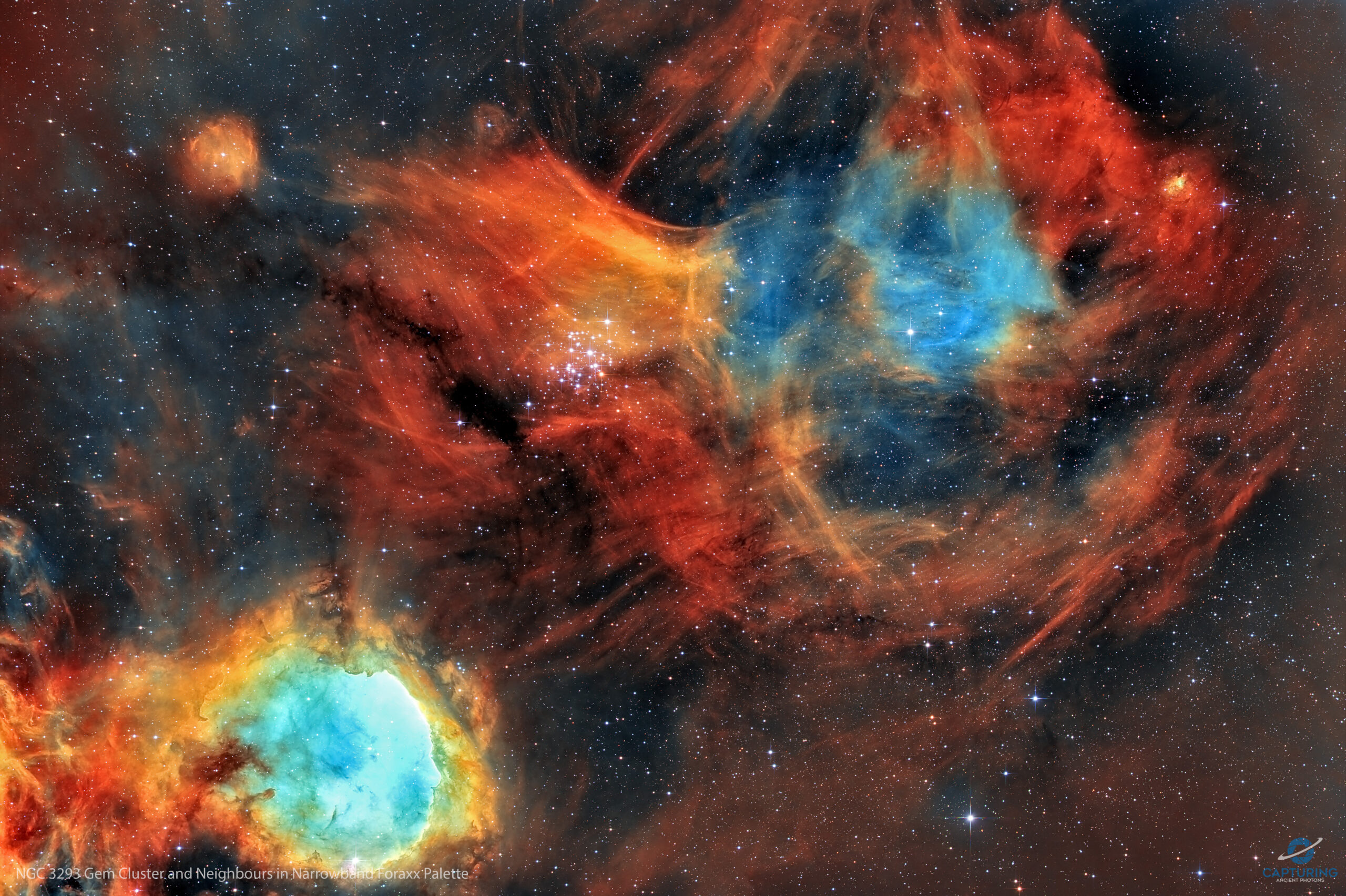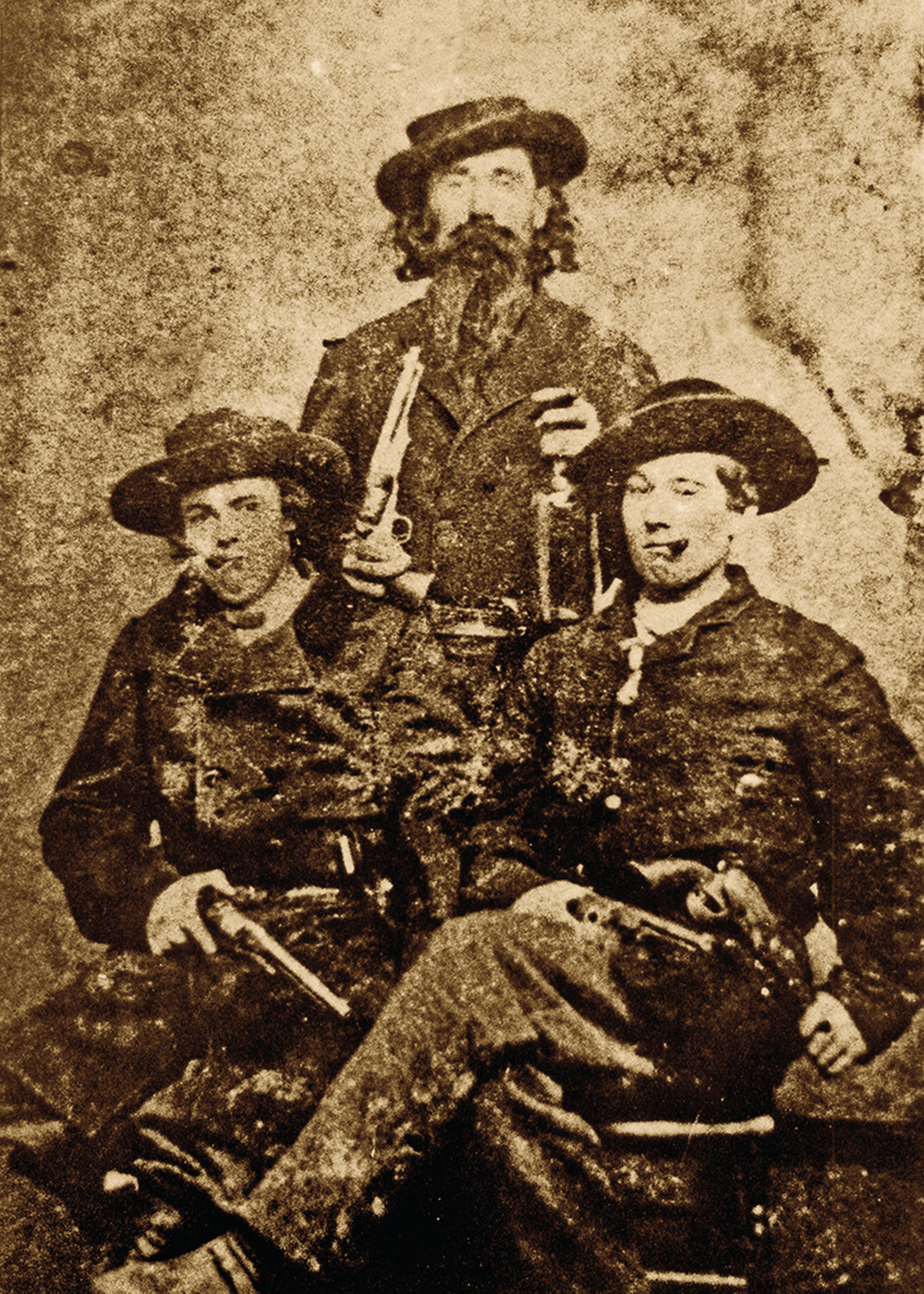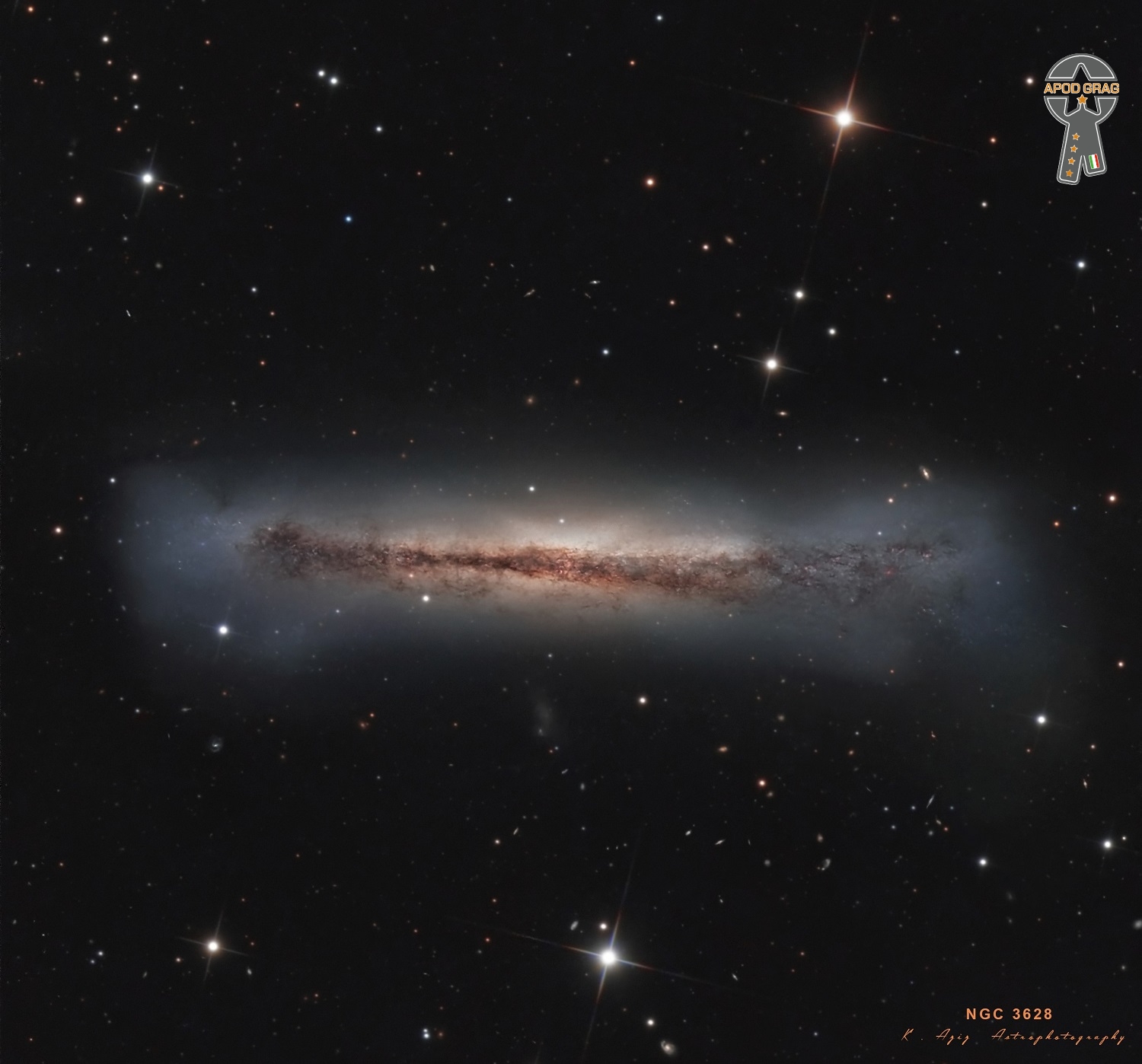Blog
The Great Carina Nebula is home to strange stars and iconic nebulas. Named for its home constellation, the huge star-forming region is larger and brighter than the Great Orion Nebula but less well known because it is so far south — and because so much of humanity lives so far north. The featured image shows in great detail the northernmost part of the Carina Nebula. On the bottom left is the Gabriela Mistral Nebulaconsisting of an emission nebula of glowing gas (IC 2599) surrounding the small open cluster of stars (NGC 3324). Above the image center is the larger star cluster NGC 3293, while to its right is the emission nebula Loden 153. The most famous occupant of the Carina Nebula, however, is not shown. Off the image to the lower right is the bright, erratic, and doomed star known as Eta Carinae — a star once one of the brightest stars in the sky and now predicted to explode in a supernova sometime in the next few million years.

Lesley Sue Goldstein (May 2, 1946 – February 16, 2015), known professionally as Lesley Gore, was an American singer, songwriter, actress, and activist. At the age of 16, she recorded the pop hit “It’s My Party“, a US number one in 1963. She followed it up with ten further Billboard top 40 hits including “Judy’s Turn to Cry” and “You Don’t Own Me“.
Gore later worked as an actress and television personality. She composed songs with her brother Michael Gore for the 1980 film Fame, for which he won an Academy Award. She hosted several editions of the LGBT-oriented public television show, In the Life, on American TV in the 2000s.
Gore was born Lesley Sue Goldstein in Brooklyn, New York City, into a middle-class Jewish family. The daughter of Leo Goldstein and Ronny Gore, her father was the owner of Peter Pan, a children’s swimwear and underwear manufacturer, and later became a leading brand licensing agent in the apparel industry.She was raised in Tenafly, New Jersey, and attended the Dwight School for Girls in nearby Englewood. She also attended Sarah Lawrence College.
more...May 2nd 1933 – 2004; Legendary and highly-respected Philadelphia pianist / keyboardist Eddie Green was a sideman on dozens of projects, and finally released two CDs as a leader, the long out-of-print debut “This One’s For You” and his posthumously-released coda Shades of Green.
After informal tutoring with Bud and Richie Powell and studying harmony, theory, composition and arranging at Combs College of Music, Eddie Green performed with the likes of Dexter Gordon, Slide Hampton, Donald Byrd, Hank Crawford, Max Roach, Betty Carter, Gary Bartz, George Coleman, Junior Cook and many others. He was on records that went “gold:” Billy Paul’s “Me and Mrs. Jones” and Lou Rawls’ “When You’ve Heard Lou, You’ve Heard It All.” His distinctive touch graced albums by guitar virtuoso Pat Martino, Sonny Criss and Jean Carn; in addition to his musicianship, his talents as as a composer were spotlighted on recordings by his own groundbreaking ’70s fusion group Catalyst, the Odean Pope Saxophone Choir, Rochelle Ferrelle and Suzanne Cloud.
Green appeared internationally at the Mt. Fuji (Japan), North Sea (Holland), Montreaux (Switzerland) and Nice (France) Jazz Festivals. Locally in Philadelphia, he was awarded honors by the Trane Stop Resource Institute, the City of Philadelphia and the Mill Creek Jazz and Cultural Society for both the 1993 and 1994 “Reader’s Choice” Best Jazz Piano. Eddie Green never omitted the listener from his Jazz equation.
more...Richard Arnold “Groove” Holmes (May 2, 1931 – June 29, 1991) was an American jazz organist who performed in the hard bop and soul jazz genre. He is best known for his 1965 recording of “Misty“.
Holmes’s first album, on Pacific Jazz with guest Ben Webster, was recorded in March 1961. He recorded many albums for Pacific Jazz, Prestige, Groove Merchant, and Muse, many of them with Houston Person.
He died of a heart attack after battling prostate cancer, having performed his last concerts in a wheelchair.One of his last gigs was at the 1991 Chicago Blues Festival with his longtime friend, singer Jimmy Witherspoon.
more...In this colorful Picture of the Week we see a portion of the Gum 10 nebula through the eyes of ESO’s Very Large Telescope in Chile. Gum 10 was discovered by the Australian astronomer Colin Stanley Gum, who in 1955 published a catalogue with more than 80 similar diffuse nebulae. The energetic ultraviolet radiation from the hot blue stars in Gum 10 ionise the gas in the nebula, stripping electrons away from their atoms. When these electrons combine again with the atoms, they emit light at very specific colours or wavelengths. The red shade in this image comes from hydrogen, the most abundant element in the Universe. The dark areas are dense clouds of dust that partially block our view of the objects behind them. This image, taken with the FORS2 instrument, was created as part of the ESO Cosmic Gems programme, an outreach initiative to produce images of interesting, intriguing or visually attractive objects using ESO telescopes, for the purposes of education and public outreach. The programme makes use of telescope time that cannot be used for science observations. All data collected may also be suitable for scientific purposes, and are made available to astronomers through ESO’s science archive.

more...
Rita Coolidge (born May 1, 1945) is an American recording artist. During the 1970s and 1980s, her songs were on Billboard magazine’s pop, country, adult contemporary, and jazz charts, and she won two Grammy Awards with fellow musician and then-husband Kris Kristofferson. Her recordings include “(Your Love Keeps Lifting Me) Higher and Higher,” “We’re All Alone“, “I’d Rather Leave While I’m in Love“, and the theme song for the 1983 James Bond film Octopussy: “All Time High“.
Coolidge was born in Lafayette, Tennessee. She is the daughter of Dick and Charlotte Coolidge, a minister and schoolteacher, with sisters Linda and Priscilla, and brother Raymond.She is of Cherokee and Scottish ancestry. She attended Nashville’s Maplewood High School and graduated from Andrew Jackson Senior High School in Jacksonville, Florida. Coolidge is a graduate of Florida State University. She is a member of Alpha Gamma Delta sorority.
more...Judith Marjorie Collins (born May 1, 1939) is an American singer-songwriter and musician with a career spanning seven decades. An Academy Award-nominated documentary director and a Grammy Award-winning recording artist, she is known for her eclectic tastes in the material she records (which has included folk music, country, show tunes, pop music, rock and roll and standards), for her social activism, and for the clarity of her voice. Her discography consists of 36 studio albums, nine live albums, numerous compilation albums, four holiday albums, and 21 singles.
Collins’ debut studio album, A Maid of Constant Sorrow, was released in 1961 and consisted of traditional folk songs. She had her first charting single with “Hard Lovin’ Loser” (No. 97) from her fifth studio album In My Life (1966), but it was the lead single from her sixth studio album Wildflowers (1967), “Both Sides, Now” – written by Joni Mitchell – that gave her international prominence. The single reached No. 8 on the BillboardPop Singles chart and won Collins her first Grammy Award for Best Folk Performance. She enjoyed further success with her recordings of “Someday Soon“, “Chelsea Morning” (also written by Mitchell), “Amazing Grace“, “Turn! Turn! Turn!“, and “Cook with Honey”.
Collins experienced the biggest success of her career with her recording of Stephen Sondheim‘s “Send in the Clowns” from her tenth studio album Judith (1975). The single peaked at No. 36 on the Billboard Pop Singles chart in 1975 and then again in 1977 at No. 19, spending 27 non-consecutive weeks on the chart and earning her a Grammy Award nomination for Best Pop Vocal Performance, Female, as well as a Grammy Award for Sondheim for Song of the Year. Judith would also become her best-selling studio album; it was certified Gold by the RIAA in 1975 for sales of over 500,000 copies and Platinum in 1996 for sales of over 1,000,000 copies.
In 2017, Collins’s rendition of the song “Amazing Grace” was selected for preservation in the National Recording Registry by the Library of Congress as being “culturally, historically, or artistically significant”.That same year, she received a Grammy Award nomination for Best Folk Album for Silver Skies Blue with Ari Hest. In 2019 at the age of 80, she scored her first No. 1 album on an American Billboard Chart with Winter Stories, a duet album with Norwegian singer, songwriter, and guitarist Jonas Fjeld featuring Chatham County Line. In 2022, she released her first studio album of all original material, entitled Spellbound.
Collins was born the eldest of five siblings in Seattle, Washington, where she spent the first ten years of her life. Her father (a blind singer, pianist and radio show host) took a job in Denver, Colorado, in 1949, and the family moved there. Her grandfather was Irish.
more...Ira Sullivan (May 1, 1931 – September 21, 2020) was an American jazz trumpeter, flugelhornist, flautist, saxophonist, and composer born in Washington, D.C., United States. An active musician since the 1950s, he often worked with Red Rodney and Lin Halliday.
Sullivan was born on May 1, 1931, in Washington, D.C., United States. His father taught him to play the trumpet beginning at age 31⁄2, and his mother taught him saxophone. He played in 1950s Chicago, Illinois, with such musicians as Charlie Parker, Lester Young, Wardell Gray and Roy Eldridge, gaining a reputation as a fearsome bebop soloist. After playing briefly with Art Blakey in 1956, and mastering alto and baritone saxophone, Sullivan moved south to Florida and out of the spotlight in the early 1960s.[3] His reluctance to travel limited his opportunities to play with musicians of the first rank, but Sullivan continued to play in the Miami area, often in schools and churches. Contact with local younger players, such as Jaco Pastorius and Pat Metheny led to teaching and to a broadening of his own musical roots to include the stylings of John Coltrane‘s jazz rock.
more...Shirley Valerie Horn (May 1, 1934 – October 20, 2005) was an American jazz singer and pianist. She collaborated with many jazz musicians including Miles Davis, Dizzy Gillespie, Toots Thielemans, Ron Carter, Carmen McRae, Wynton Marsalis and others. She was most noted for her ability to accompany herself with nearly incomparable independence and ability on the piano while singing, something described by arranger Johnny Mandel as “like having two heads”, and for her rich, lush voice, a smoky contralto, which was described by noted producer and arranger Quincy Jones as “like clothing, as she seduces you with her voice”.
Shirley Horn was born and raised in Washington, D.C. Encouraged by her grandmother, an amateur organist, Horn began piano lessons at the age of four. Aged 12, she studied piano and composition at Howard University, later graduating from there in classical music. Horn was offered a place at the Juilliard School, but her family could not afford to send her there. Horn formed her first jazz piano trio when she was 20.
more...Marion Walter Jacobs (May 1, 1930 – February 15, 1968), known as Little Walter, was an American bluesmusician, singer, and songwriter, whose revolutionary approach to the harmonica had a strong impact on succeeding generations, earning him comparisons to such seminal artists as Django Reinhardt, Charlie Parker and Jimi Hendrix. His virtuosity and musical innovations fundamentally altered many listeners’ expectations of what was possible on blues harmonica. He was inducted into The Rock and Roll Hall of Fame in 2008, the first and, to date, only artist to be inducted specifically as a harmonica player.
Jacobs’ date of birth is usually given as May 1, 1930, in Marksville, Louisiana. He was born without a birth certificate and when he applied for a Social Security card in 1940, his birthdate was listed as May 1, 1923. Over the years he often gave different years, but May 1 was constant. In some other documents he filled out before reaching the age of majority he indicated birth years of 1925 and 1928, probably to appear to be of legal age to sign contracts for recordings and club work.
more...
Featured is a high-resolution view of the magnificent spiral galaxy NGC 3628 and its galactic disk inflated and divided by dark dust lanes. Of course, this galactic portrait recalls its popular nickname: the Hamburger Galaxy!
Located about 35 million light-years away from us in the direction of the Leo constellation, NGC 3628 shares its neighborhood with two other large spiral galaxies : M65 and M66 in a famous group known as the Leo Triplet. Gravitational interactions with its cosmic neighbors are responsible for the extension and deformation of this spiral’s disk visible in the image.

Beres Hammond OJ (born Hugh Beresford Hammond; 28 August 1955, in Annotto Bay, Saint Mary, Jamaica) is a Jamaican reggae singer known in particular for his lovers rock music. While his career began in the 1970s, he reached his greatest success in the 1990s.
Born the ninth of ten children, Hammond grew up listening to his father’s collection of American souland jazz music including Sam Cooke and Otis Redding. He was further influenced by the native music of ska and rocksteady, in particular Alton Ellis.
more...Joseph Thomas “Coke” Escovedo (April 30, 1941 – July 13, 1986) was an American percussionist, who came from a prominent musical family including five musician brothers and his niece, Sheila E. He played in various genres, including R&B, jazz fusion and soul, with bands including Santana, Malo, Cal Tjader, and Azteca.
Escovedo was born in Los Angeles, California, the son of Pedro Escovedo, a plumber and amateur musician, who had immigrated from Mexico at age 12, and Anita (née Valenzuela). Escovedo grew up in the East Bay region of the San Francisco Bay Area. He developed an early interest in jazz and Latin music through exposure gained from his father Pedro, an aspiring big band singer, and eventually gravitated to drums and Latin percussion. Coke’s older brother, fellow percussionist Pete Escovedo, recruited Escovedo for a local Latin jazz combo led by pianist Carlos Federico. The Federico combo evolved into the Escovedo Brothers Band, which also counted Pete, bassist brother Phil Escovedo, saxophonist-flautist Mel Martin and trombonist Al Bent among its regular members.
more...Reverend Gary Davis, also Blind Gary Davis (born Gary D. Davis, April 30, 1896 – May 5, 1972), was a blues and gospel singer who was also proficient on the banjo, guitar and harmonica. Born in Laurens, South Carolina and blind since infancy, Davis first performed professionally in the Piedmont blues scene of Durham, North Carolina in the 1930s, then converted to Christianity and became a minister. After moving to New York in the 1940s, Davis experienced a career rebirth as part of the American folk music revival that peaked during the 1960s. Davis’ most notable recordings include “Samson and Delilah“ and “Death Don’t Have No Mercy“.
Davis’ fingerpicking guitar style influenced many other artists. His students included Stefan Grossman, David Bromberg, Steve Katz, Roy Book Binder, Larry Johnson, Nick Katzman, Dave Van Ronk, Rory Block, Ernie Hawkins, Larry Campbell, Bob Weir, Woody Mann, and Tom Winslow. He also influenced Bob Dylan, the Grateful Dead, Wizz Jones, Jorma Kaukonen, Keb’ Mo’, Ollabelle, Resurrection Band, and John Sebastian(of the Lovin’ Spoonful).
Davis was born in Laurens, South Carolina in the Piedmont region. Of the eight children his mother bore, he was one of two who survived to adulthood.
more...More Posts
- Slam Stewart
- World Music Jiraan
- Daily Roots Umberto Echo
- Frida Kahlo Power of the Cat
- Mt Zion Shabbat for the Soul
- Cosmos Barnard 150
- Billy Bang
- Red Mitchell
- Vi Redd
- Chico Hamilton
- Daily Roots Zion I Kings
- Flamenco Fridays Vicente Amigo
- Cosmos ESO 217-25
- David Bromberg
- Mama Cass
- Muhal Richard Abrams
- Lovie Austin
- World Music Etran de L’Aïr
- Daily Roots I Roy
- Living in the Twilight Zone